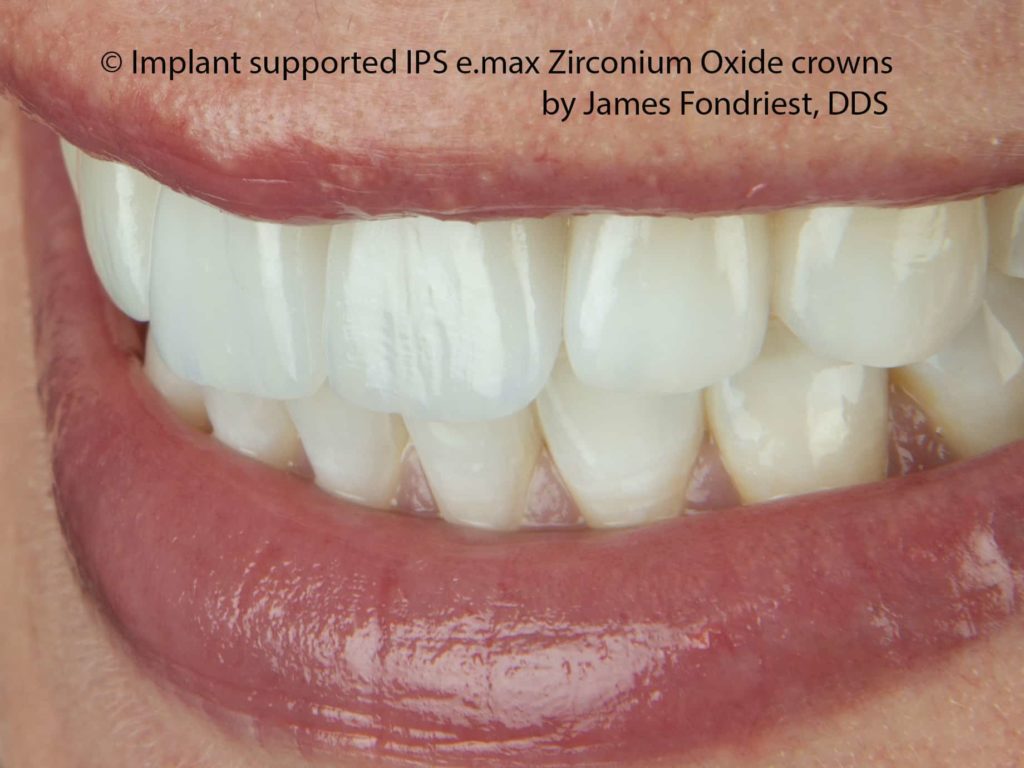
Implant crowns can be made both strong and as beautiful as the two front teeth are.
The latest advances in dental implants and Bioteeth technology
If you’ve done any research at all about replacing your missing teeth, then you’ve more than likely read about dental implants. These cutting-edge devices are comprised of three parts: the implant, which an oral surgeon or periodontist inserts into the jawbone; the abutment, which connects the implant to the artificial tooth or teeth; and the restoration, also called the dental prosthetic, which replaces the visible portion of a missing tooth. Dental professionals and patients alike love dental implants because they closely mimic the natural structure of a real tooth and thus offer a higher level of stability and restored function than other options like removable dentures. Today, Dr. James Fondriest, an experienced restorative dentist located in the 60045 zip code area, offers a bit of dental implant history and discusses how current research is pushing dental implant technology forward.
A Brief History of Dental Implants
Although primitive dental implants made of carved shell or bone have been found dating back thousands of years, modern dental implants truly became a viable tooth replacement option in the 1950s when Swedish researchers discovered the biocompatible properties of titanium. The ability of titanium to fuse with human bone prompted the first dental implant procedure in 1952. Since then, dental implants have improved due to a number of advances in both materials and technique, including:
- Using sandblasting and acid etching to create a roughened surface on the implant. The roughened surface actually creates a stronger fusion with jawbone tissue.
- The discovery that implants are just as successful when placed immediately into a socket where a compromised tooth has been removed as they are when placed into a fully healed socket helped decrease total procedure duration.
- The use of zirconia in dental restorations allows for improved aesthetics even in the back of the mouth where extreme bite force necessitates more durable materials.
But where is current dental implant research leading the industry and when will the realm of science fiction become science fact?
New Research Emerges on Bioteeth
Researchers at King’s College of London, led by Professor Paul Sharpe, have made headway into the field of bioteeth, functional teeth that are biologically grown from stem cells. Their most recent findings, published in the Journal of Dental Research, showed that epithelial cells gathered from the gum tissue of adult subjects could be implanted into the embryonic teeth cells of mice and grow into fully functional human-mouse hybrid teeth. In the future, this could mean that we could grow our own replacement teeth rather than have to rely of dental prosthetics like bridges or dental implants. Of course, ethical concerns over the use of embryonic stem cells, as well as their lack of ready availability, mean that bioteeth won’t be on the market for a number of decades. However, once researchers can figure out a way to culture adult epithelial cells so that they behave like embryonic stem cells, we might see bioteeth technology hit the mainstream.
New Material Improves the Success Rate of Dental Implants
According to the American Association of Oral and Maxillofacial Surgeons, dental implants have an average 95% success rate. While this is certainly a number to be proud of, if you’re one of those patients who fall into the 5% failure rate, you’re not likely to be very happy with the dental implant procedure. Implant failure most often occurs when the implant itself, that part the surgeon implants into the jaw bone, fails to fully osseointegrate (fuse with) the surrounding bone tissue. The most common causes for dental implant failure include poor oral hygiene, placing too much pressure on the implant before it has fully healed, and certain habits like smoking.
To help improve the success rate of dental implants, scientists at Universitat Jaume I (UJI) in Castellón, Spain have developed a special coating that is applied to the surface of the implant. When the coating comes into contact with the bone tissue, it breaks down and releases bioactive compounds that stimulate bone generation. For people with compromised jawbone tissue, this new innovation could make dental implants a reality. However, researchers note, that this technology is still in the development phase and may take another 2-3 years for a product to hit the market.
Mini Implants
At less than 3 mm in diameter, mini dental implants, or MDIs, are smaller than regular implants but the implantation process is the same. Mini implants are ideal for older patients with low jawbone density because trauma to the bone and the recovery time are both reduced. Because more mature dental patients generally do not require stability or longevity, mini implants are an effective option. On the other hand, if you lose your teeth while young, full-sized implants would be the treatment option of choice because they are stronger and more durable.
Talk to your dentist about the advancements in Dental Implant Technology
If you’re missing one or more of your adult teeth, you owe it to yourself to learn more about tooth replacement with dental implants. To schedule a consultation with Dr. James Fondriest at his Lake Forest dentist office, contact us at (847) 234-0517. Dr. Fondriest proudly offers general, cosmetic, and restorative dentistry services to patients from Lake Forest and the North Shore suburbs near Chicago.
